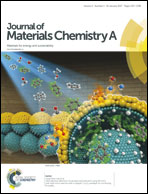Graphene highly scattered in porous carbon nanofibers: a binder-free and high-performance anode for sodium-ion batteries†
Abstract
Graphene monolayers or bilayers highly scattered in porous carbon nanofibers (denoted as G/C) are first prepared by a feasible electrospinning technique. Meanwhile, G/C with the character of a flexible membrane adherent on copper foil is directly used as binder-free anode for Na-ion batteries, exhibiting fascinating electrochemical performance in terms of high reversible capacity (432.3 mA h g−1 at 100 mA g−1), exceptional rate capability (261.1 mA h g−1 even at 10 000 mA g−1), and ultra-long cycling life (91% capacity retention after 1000 cycles). This is due to the synergistic effect between the highly exfoliated graphene layers and the porous carbon nanofibers, which can provide massive active Na-storage sites, ensure sufficient electrolyte infiltration, offer open ionic diffusion channels and oriented electronic transfer pathways, and prevent graphene agglomeration as well as carbon nanofiber fracture upon prolonged cycling. The findings shed new insights into the quest for high-performance carbon-based anode materials of sodium-ion batteries.



 Please wait while we load your content...
Please wait while we load your content...